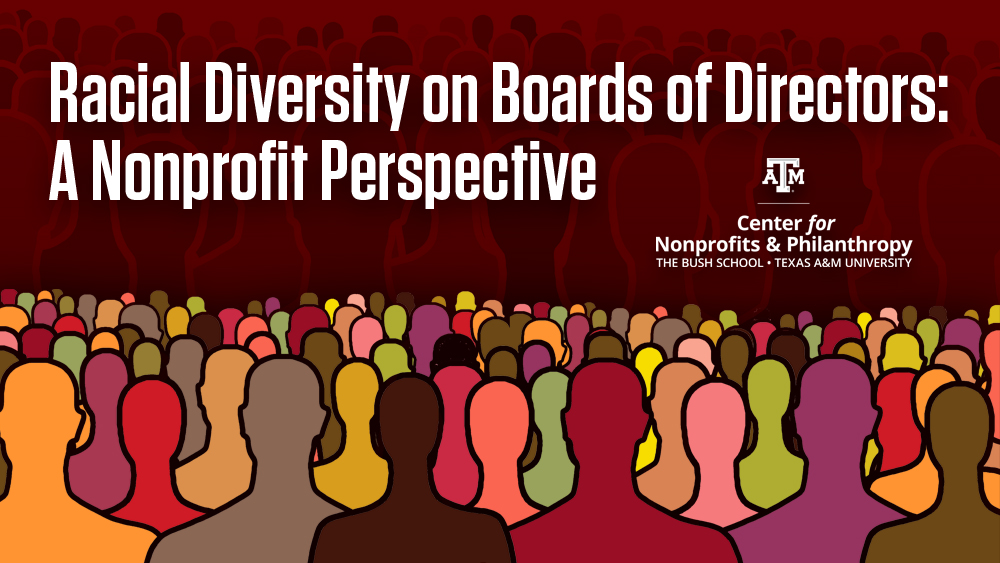
“When we talk about racial justice, we talk about power and needing to have seats at the table,” California’s governor said during a press conference about a new law requiring corporate boards to diversity their membership.
The new California requirements did not apply to nonprofit boards of directors. And yet, achieving diversity also remains a vexing challenge for nonprofit executives and volunteer leaders. Even today, most nonprofit boards remain predominantly white and disproportionately male, according to Dr. William Brown, Director of the Center for Nonprofits and Philanthropy, who has been studying the effects of racial diversity on nonprofit boards for nearly 20 years.
“This effort was undertaken to explore the experiences of people of color on nonprofit boards, to understand the themes they narrate regarding their experiences, and to set the stage for further research on the topic.”
The challenge persists, even though the benefits of such diversity are clear. A growing body of research indicates that nonprofit organizations with demographically diverse boards are more adept at planning and strategy development, especially in complex and challenging operating contexts. Increasing diverse representation can also improve resiliency. In most cases, the benefits of board diversity greatly outweigh the costs, such as an increased need to build strong bonds among board members.
The Center for Nonprofits and Philanthropy, which was established in 2017 at the Bush School of Government and Public Service, is committed to improving our understanding of the effects of racial diversity and the techniques and strategies utilized to increase diversity and inclusion in the nonprofit sector. In 2019, Dr. Kenneth Anderson Taylor, the Center’s Director of Outreach and Professional Development, began work on a study of people of color serving as board members at nonprofit organizations. Conducting research under COVID-19 has posed some challenges, but according to Dr. Taylor, “The lopsidedness of how Blacks and others of color continue to be impacted by coronavirus and racism served as additional motivation to dig back into my research, and though many nonprofit scholars have addressed these issues, maybe something will change this time around.”
To date, Dr. Taylor has interviewed nearly fifty board members of color from charitable organizations, primarily in the states of Texas and Colorado. Although the work is still ongoing, some of the findings are so timely that he felt the need to share preliminary impressions:
- while board members at nonprofits tended to have few concerns about their ability to address strategic planning, governance, and fundraising, they have found no comfort or routineness confronting inclusion, diversity, and equity;
- Blacks and others of color experienced ill-treatment, which felt like a confirmation of only being there due to the need to have at least “one of us” on the board;
- having a profound desire to serve on boards, many people of color experienced the challenge of even getting in the room to be considered for such a role;
- in nonprofit board environments, board members of color questioned their value to the organization, which led to feelings of giving up on their commitment to service;
- people of color thought that the likelihood of enhanced cultural diversity on boards to any significant degree was unlikely in the foreseeable future;
- Blacks and others of color felt nonprofit boards just didn’t know where to start; in this particular instance, the board intentionally recruited someone Black to advise members in the direction of advancing equity and inclusion; and
- negative treatment experienced by Blacks and others of color on boards had to do with what was perceived as generational differences and “keeping younger members at bay” versus outright racism.
This effort was undertaken to explore the experiences of people of color on nonprofit boards, to understand the themes they narrate regarding their experiences, and to set the stage for further research on the topic. This most recent data enhances the Center’s ability to support nonprofit organizations and guide subsequent research. Over the next twelve to eighteen months, faculty at the Center for Nonprofits and Philanthropy will continue a dual approach of grounded research and applied practice to help strengthen nonprofits in Texas and beyond.

